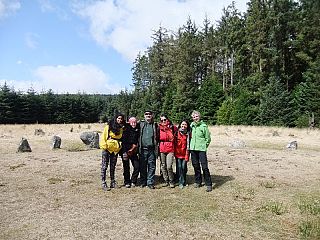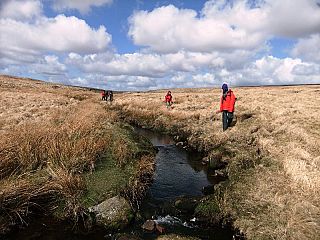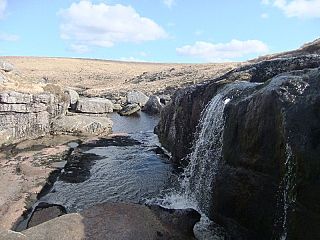Dartmoor walks this way | News
Dart Pilgrimage
The River Dart is treasured by staff and students at Schumacher College in Dartington. It runs just a few hundred metres from the college grounds and offers a tranquil place to walk, picnic, watch for wildlife, paddle a canoe or take a bracing swim. So it’s not surprising that a few of the Masters students this year wanted to mark the end of their residential stay with a pilgrimage of the Dart from source to mouth. From Postbridge downwards, the East Dart and then the “Double Dart” is easy to follow, but finding its source in a boggy hollow high up in one of the remotest parts of northern Dartmoor is a challenge if you don’t know the terrain or much about navigation. As that is the only part of the Dart I haven’t yet walked myself, I offered to go with them on the first day.
The four pilgrims – women from China, Mexico, France and UK/India – left their camping equipment in Postbridge and drove with myself and a couple of other day walkers to Fernworthy reservoir. We stopped in the stone circle and burnt some sage to bring us good energy, then headed westwards to the open moor. It’s quite a moment when you emerge from the conifers and see the vast expanse of bare hills, with the ruined enclosures and buildings of Teignhead Farm nestling in the valley. They provide a sheltered spot to have a sunbath, before the hard slog in the face of the fierce northwesterly wind to the top of Whitehorse Hill (the third highest spot on the moor). It was new terrain to all my companions and the sheer emptiness blew them away (almost literally at times). Descending the western slope and finding, in amongst the marshy humps and tussocks, the first little flowing channel of water was like meeting an old friend. By this point the four pilgrims were barefoot, skipping over the grass and wading in the water. The channel widens and the water speeds up really quickly. The hills around this part of the moor don’t just feed the Dart – the Teign begins nearby, the Taw and the East and West Okements are just over the hill. It’s extraordinary to think how much water is stored in these peat bogs and gradually released into the surrounding lowlands.
The ever-widening East Dart loops around a large marshy area at which point we had to climb above it, taking the opportunity to visit Statt’s House, a ruined peat-cutter’s dwelling on the top of Winney’s Down. The view was one of the most amazing I’ve seen on Dartmoor – all the way southeast to Rippon Tor and Buckland Beacon, north and westwards to the high moor, and the lowlands of north and south Devon beyond. Clearly Mr. Statt liked his views and didn’t mind wind. Back down to the river beyond the marsh, and we began to find a proper valley with granite outcrops and tinners’ mounds. It was a delightful spot after the bleak expanses we’d been crossing: skylarks were singing in the afternoon sun, and ponies grazed nearby (even they hadn’t ventured further upstream). By now the walking was easy, a gentle descent following the snaking river, another pause by the waterfall, and then a well trodden trail south to Postbridge where the pilgrims were to camp. I hope they slept well that night – I did!










